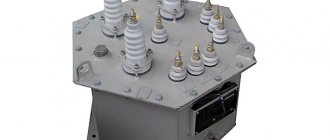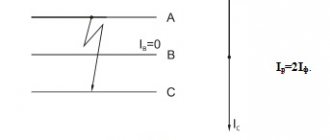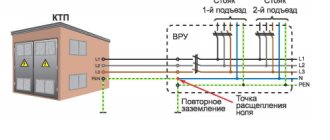A transformer is an element of an electrical circuit designed to convert electricity from one indicator to another. During operation, a current with certain indicators is supplied to the primary winding (facing the electrical circuit). It moves onto the transformer core and interconnects both windings. Next, the current moves through the secondary and is already moving towards the recipient. Thus, businesses, homes, educational and government institutions can use electricity suitable for operating electrical appliances.
Depending on the number of coils, the transformer is a step-up or step-down transformer. The output current can be either lower or higher than the incoming one. If there are more turns on the primary winding than on the secondary, then the transformer is a step-down transformer. If it’s the other way around, then it’s increasing. This does not change the installation of the transformer and the same steps are carried out.
They are used, for example, in transformer blocks that distribute electricity to residential buildings and apartments. A current with one value is supplied to the primary, and a converted current is supplied to our homes, with a rated voltage of 220 volts.
Transformer design
To carry out a full installation of the transformer, you need to understand its design. Despite the complexity of the work performed, it is designed simply.
- Core. An unchangeable element of the transformer block. It is the connecting link between two windings. Made from electrical steel. It is an alloy with silicon, sometimes with aluminum. It is located in a special tank on which the winding terminals are installed;
- Tank. Core reservoir. It has several additional elements on its body: a pipe (required for emergency removal of gas from the tank, which prevents explosions), gas protection (turns off the transformer if damaged), an expander (equalizes the level of oils inside the tank), an oil drain connector (connects the tank with the expander) ;
- Thermosyphon filter. Regenerates oils, preventing moisture or oxidation of the liquid;
- Drain valves. Allows you to regulate the amount of oil inside.
Preparation for installation of transformers in Moscow and the Moscow region
Preliminary actions are:
Pre-installation activities:
- creation of a foundation and oil receiver filled with gravel - to ensure the possibility of collecting oil in case of damage to the unit;
- organizing a site for carrying out operations for checking, warming up and assembling equipment;
- preparation of access roads, means of transporting the unit to the installation area, lifting devices and accessories for installation;
- preparation of transformer oil, filling system, tanks, indicator silica gel.
Acceptable methods of transportation, depending on the type of TB
- Large-sized TB (more than 90 tons) in disassembled form. All leads, expanders, and filter units are disconnected. The oil tank must be filled with some inert gas;
- TB weighing up to 90 tons are also transported partially disassembled, but have a number of assumptions. The tank can be initially filled with oil for ease of subsequent installation;
- Small transformers can be transported fully assembled and filled with oil. Immediately after shipment they can be mounted on the mounting location.
Requirements for the road surface are also given. It should be level and have a slope of no more than 7. Its size is very important, because the lack of proper space for maneuvering the car can lead to additional problems.
What are the requirements
Transformer installation technology has the following requirements:
- To the quality of assembly of the magnetic circuit. Before assembly, all magnetic gaps, gaps between magnetic washers and the core, and gaps at the joints of magnetic cores must be installed.
- To the quality of the connection between the magnetic core and the rod part. The core part must be rigid and uniform. The connections must ensure tight and reliable attachment to the rod.
- To the quality of mechanical processing (only manual processing is allowed).
- To the quality of coatings (surface unevenness and burrs are not allowed).
Installation rules are common for all types of electrical devices, since they are characterized by a wide variety of operating conditions, which necessitates the selection of methods for their installation, taking into account specific features.
Installation of a transformer of 110 kV and above is carried out at an open height and involves the use of installation cranes. In some cases, special mounting mechanisms are used. Typically, the crane moves along the magnetic core frame along its longitudinal axis. In order to reduce the transverse forces arising from the weight of the magnetic core, mounting crossbeams are used, which simultaneously serve as guides when moving the crane along the magnetic core.
Installation of power oil three-phase two-winding and single-phase two-winding power oil two-winding or oil-free switches with natural and pneumatic control systems, as well as high-voltage disconnectors, separators and short circuiters. Performed during major repairs, scheduled maintenance, by decision of the technical condition commission or at the written request of the energy service. As a result of the work, outgoing power lines that are not subject to replacement, repair or repair after testing are disconnected. The voltages at the inputs to the 0.4 kV switchgear are reduced, a partial oil change is carried out, oil is washed and dried, and, if necessary, the system of oil-filled inputs is evacuated, oil barriers and oil risers are washed. During the repair process, other types of work may be performed as provided for in the technical documentation for the switch and disconnector.
Preparation for installation
Installation of a transformer requires full preparation. Due to the size and weight of the equipment, it is necessary to prepare a seat.
The preparation stages include:
- Creating a foundation. When installing the foundation, it is important to take into account the oil collection pit. In case of emergency situations, in which a transformer explosion is likely, all liquid will be drained into a special compartment.
- Inspection and revision of the device. It is important that the transformer is fully operational and free of damage. The slightest damage to the winding or core leads to incorrect operation. It is also important to consider the size during installation. The transformer must fit completely onto the landing pad.
- Transportation routes are established. The weight and fragility of the transformer do not allow it to be moved by hand. For convenient transportation, special transport routes are required. The block will be transported along them to its destination.
- Preparing oil tanks. They should be prepared in advance, and temporary tanks are also needed to store oils before filling.
- Preparing silica gel for the absorber.
Transformer assembly
Before installing the device on the foundation, you must additionally mount all the necessary elements on the housing in the following order:
- Radiator units;
- Gas relay;
- Expander;
- Oil level sensor;
- Filters;
- Output contacts;
- Current transformers;
- Control devices.
Some items require pre-installation unpacking. The event requires certain conditions. It is advisable to carry out work in dry, clear weather. If the humidity is more than 85 percent, it is worth carrying out all manipulations in the room.
Transformer installation steps
After all the preparatory work, you can proceed to the installation itself. Here we will use the base that we made in advance.
- Unloading the unit and installing it on the “rails”;
- Transportation of the transformer to the installation site;
- Equipment integrity check;
- Installation of the transformer on the foundation;
- Installation test;
- Commissioning.
Initially, a test input is carried out at idle. Then a load test must be carried out.
Dismantling the transformer
If the transformer is damaged or has exceeded its permitted service life, it will need to be replaced. Dismantling the transformer also requires preparatory work.
During repair work, not the entire unit is dismantled. Separately disconnecting parts of the circuit allows you to fully determine the cause of the breakdown. When disassembling the unit, it is important to mark all parts that can be confused during subsequent installation.
Installation procedure
The transformer installation sequence includes:
- preparation and placement of elements;
- core assembly and installation;
- insulation and coating of windings with oil or compound;
- installation, fastening and fastening of the magnetic core to the housing.
The installation order is determined by the type and size of the core. The assembly of the core consists in the fact that one of the core plates (along the development) is fixed motionless, and the remaining plates are stacked one on top of the other, and each of them is clamped in the grooves. When assembling a core from plates, you can use a simple method by first arranging the plates using template plates
Installation of transformer equipment, in general, consists of the following main operations: installation of main components and securing them to mounting bases, installation of windings, filling and vacuuming, assembly quality control. The main components are the frame, panels, covers, etc. — serve to place components and secure them to mounting bases.
Dimensional groups of transformers
To begin with, it should be noted that in order to regulate installation work, transformers were classified by size, namely:
- Transformers I: voltage up to 35 kV, power up to 100 kVA.
- Power transformers of size II: voltage up to 35 kV, power from 100 to 1000 kVA incl.
- Transformers of size III: voltage up to 35 kV, power from 1000 to 6300 kVA incl.
- Power transformers of IV size: voltage up to 35 kV, power over 6300 kVA.
- Transformers of V dimensions: voltage from 35 to 110 kV, power up to 32000 kVA.
- The latest dimensional class of transformers is VIII: over 110 kV.
Instructions for installation of general purpose transformers with voltage up to 110 kV, power up to 80,000 kVA incl. identical.
Installation of transformers from size IV is carried out only according to a previously prepared PPR (works project), based on the basic PPR.
Introduction about installing a power transformer
Installation of a power transformer is an electrical installation work of increased complexity and cannot be carried out by non-qualified personnel of electrical companies.
The stages of transformer installation work are strictly regulated. Installation should be carried out only by highly qualified specialists from electrical installation companies, electrical and electrical measuring laboratories and other similar organizations with experience in such work and the necessary tools. For example, the company “Complex Energy Contract”, company website energyc.ru/service/montazh/montazj-transformatorov.
Things to consider before starting installation
Before proceeding with the installation of the vehicle, you will need to resolve a number of issues related to preparation for this procedure.
Storage conditions
Before installation, the product is stored in a dry and well-ventilated area, in which the temperature does not fall below 5 degrees and the humidity does not exceed 80%. Measures must also be taken to prevent severe contamination and mechanical damage to the vehicle body. Before long-term storage, it is not necessary to remove the original packaging from hermetically sealed products.
Preliminary inspection
If the transformer is intended to be installed immediately, it is necessary to remove it from the original packaging, which will require:
- Remove the protective covers (if equipped).
- Remove accumulations of dust using compressed air, and wipe particularly dirty areas with a dry cloth.
- Inspect all surfaces to ensure they are free of any scratches or other damage.
- If plans for installation time have changed, you should repack it at least in oiled paper.
If the vehicle is planned to be installed in the near future, it is necessary to check its technical condition.
Functionality check
During the preliminary inspection, immediately after removing the packaging, you must carefully examine all mechanical components of the new product. Particular attention is paid to:
- integrity of power windings;
- state of the magnetic circuit;
- tightening the bolts.
You should also carefully examine the quality of the pressing (both windings and magnetic circuit).
Pressing and crimping
When checking the quality of pressing and making a decision on additional pressing of products with pressure screws, it is important to take into account that both their windings and the magnetic circuit are already pressed along the center line. In the event that there is a need to strengthen it, the existing fastenings should first be loosened.
Only after this can you begin to press the winding again using pressure screws. Upon completion of this procedure, it is necessary to check the compaction of the magnetic circuit again.
Insulation check
To check the insulation of winding wires for the absence of short circuits to the magnetic circuit, as well as studs and steel rings, a megger rated for a voltage of 1000 Volts is used. To measure the same parameter, but with respect to individual windings of the product, you will need a 2500 Volt device. At temperatures of 20-30 degrees, the insulation indicator must be at least 100 (300) MΩ (for transformers up to 6 kV and more than 6 kV, respectively).
Winding resistance measurement
Winding resistance is measured in direct current mode and checked in all branches of the structure. The spread of the indicator for branches of the same name (depending on the phase distribution of the windings) should not exceed 2%. If the product passport contains other numbers, you should focus on them.
If the values do not correspond to the norm, additional drying will be required before commissioning.
Checking the transformation ratio
This parameter is also measured on all branches of this product. To carry out these procedures, special equipment is used, selected in accordance with the approved test methodology. It involves measuring the exact ratio of the number of turns in each winding.
Installation requirements and standards
Before starting to operate the vehicle, it must be additionally dried at permissible temperatures of about 80-100°. This procedure continues until the winding insulation resistance stops changing its value within 8-12 hours.
When installing the transformer, the following installation standards must be observed:
- It is recommended to position it so that the distance to the nearest walls and neighboring objects that impair normal cooling conditions is at least 500 mm.
- After installation at the site of operation, the vehicle is reliably grounded (for this purpose, an external grounding circuit is installed outside the premises).
- The transformer is mounted on a well-leveled base capable of supporting the appropriate weight.
In a room with a transformer located in it, it is necessary to have effective ventilation.











